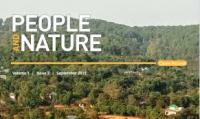International scientists seek pathways to sustainability
Sept. 4, 2020
An international group of sustainability scientists work to understand the most effective targets at which to aim to enabling leaders in government, business, civil society and academia to spark transformative changes towards a more just and sustainable world. The work appears in the British journal People and Nature.
As a component of the IPBES Global Assessment, the group conducted an iterative expert deliberation process with an extensive review of scenarios and pathways to sustainability, including the broader literature on indirect drivers, social change and sustainability transformation.
The group asked what are the most important elements of pathways to sustainability? Applying a social–ecological systems lens, they identified eight priority points for intervention (leverage points) and five overarching strategic actions and priority interventions (levers), which appear to be key to societal transformation.
The work was written by Kai M. A. Chan1 | David R. Boyd1 | Rachelle K. Gould2 | Jens Jetzkowitz3 | Jianguo Liu4 | Barbara Muraca5 | Robin Naidoo1,6 | Paige Olmsted1 | Terre Satterfield1 | Odirilwe Selomane7 | Gerald G. Singh8 | Rashid Sumaila9 | Hien T. Ngo10 | Agni Klintuni Boedhihartono11 | John Agard12 | Ana Paula D. de Aguiar13,14 | DolorsArmenteras15 | Lenke Balint16 | Christopher Barrington-Leigh17 | William W. L. Cheung8 | Sandra Díaz18 | John Driscoll1 | Karen Esler19 | Harold Eyster1 | Edward J. Gregr1 | Shizuka Hashimoto20 | Gladys Cecilia Hernández Pedraza21 | Thomas Hickler22,23 | Marcel Kok24 | Tanya Lazarova24 | Assem A. A. Mohamed25 | Mike Murray-Hudson26 | Patrick O'Farrell27 | Ignacio Palomo28,29 | Ali Kerem Saysel30 | Ralf Seppelt31,32 | Josef Settele33,34 | Bernardo Strassburg35 | Dayuan Xue36 | Eduardo S. Brondízio37
Key to their affiliations:
1 Institute for Resources, Environment and Sustainability, The University of British Columbia, Vancouver, BC, Canada; 2 Environmental Program and Rubenstein School of Environment and Natural Resources, University of Vermont, Burlington, VT, USA; 3 Museum für Naturkunde Berlin, Leibniz Institute for Evolution and Biodiversity Science, Berlin, Germany; 4 Center for Systems Integration and Sustainability, Michigan State University, East Lansing, MI, USA; 5 Department of Philosophy, Environmental Studies, University of Oregon, Eugene, OR, USA; 6 World Wildlife Fund, Washington, DC, USA; 7 Centre for Complex Systems in Transition, Stellenbosch University, Stellenbosch, South Africa; 8 Nippon Foundation-Nereus Program, Institute for the Oceans and Fisheries, University of British Columbia, Vancouver, BC, Canada; 9 Fisheries Economics Research Unit, Institute for the Oceans and Fisheries and Liu Institute for Global Issues, The University of British Columbia, Vancouver, BC, Canada; 10Intergovernmental Science-Policy Platform on Biodiversity and Ecosystem Services (IPBES), IPBES Secretariat, Bonn, Germany; 11Faculty of Forestry, Forest Sciences Centre, University of British Columbia, Vancouver, BC, Canada; 12Department of Life Sciences, St. Augustine Campus, University of the West Indies, Saint Augustin, Trinidad and Tobago; 13Stockholm Resilience Centre, Stockholm University, Stockholm, Sweden; 14Brazilian Institute for Space Research (INPE), São José dos Campos, Brazil; 15Universidad Nacional de Colombia (Sede Bogotá), Facultad de Ciencias, Departamento de Biología, Grupo de Ecología del Paisaje y Modelación de Ecosistemas ECOLMOD, Bogotá, Colombia; 16BirdLife International, Cambridge, UK; 17Institute for Health and Social Policy, and School of Environment, McGill University, Montreal, QC, Canada; 18Consejo Nacional de Investigaciones Científicas y Técnicas, Instituto Multidisciplinario de Biología Vegetal (IMBIV), Faculta de Ciencias Exactas, Físicas y Naturales, Universidad Nacional de Córdoba, Córdoba, Argentina; 19Department of Conservation Ecology & Entomology & Centre for Invasion Biology, Matieland, South Africa; 20Department of Ecosystem Studies, The University of Tokyo, Bunkyo, Japan; 21The World Economy Research Center, Havana, Cuba; 22Senckenberg Biodiversity and Climate Research Centre (BiK-F), Frankfurt/Main, Germany; 23Department of Physical Geography, Geosciences, Goethe-University, Frankfurt, Germany; 24PBL Netherlands Environmental Assessment Agency, The Hague, The Netherlands; 25Agricultural Research Center (ARC), Central Laboratory for Agricultural Climate (CLAC), Giza, Egypt; 26Okavango Research Institute, University of Botswana, Maun, Botswana; 27Percy Fitz Patrick Institute of African Ornithology, University of Cape Town, Cape Town, South Africa; 28Basque Centre for Climate Change (BC3), Leioa, Spain; 29Laboratoire d’Ecologie Alpine, CNRS–Université Grenoble Alpes, Grenoble, France; 30Institute of Environmental Sciences, Boğaziçi University, Istanbul, Turkey; 31Department. of Computational Landscape Ecology, Helmholtz Centre for Environmental Research–UFZ, Leipzig, Germany; 32Institute of Geoscience & Geography, MartinLuther-University Halle-Wittenberg, Halle (Saale), Germany; 33German Centre for Integrative Biodiversity Research-iDiv, Leipzig, Germany; 34Department of Community Ecology, UFZ-Helmholtz Centre for Environmental Research, Halle, Germany; 35International Institute for Sustainability, Estrada Dona Castorina, Rio de Janeiro, Brazil; 36School of Life and Environmental Science, Minzu University of China, Beijing, China and 37Department of Anthropology, Indiana University, Bloomington, IN, USA







